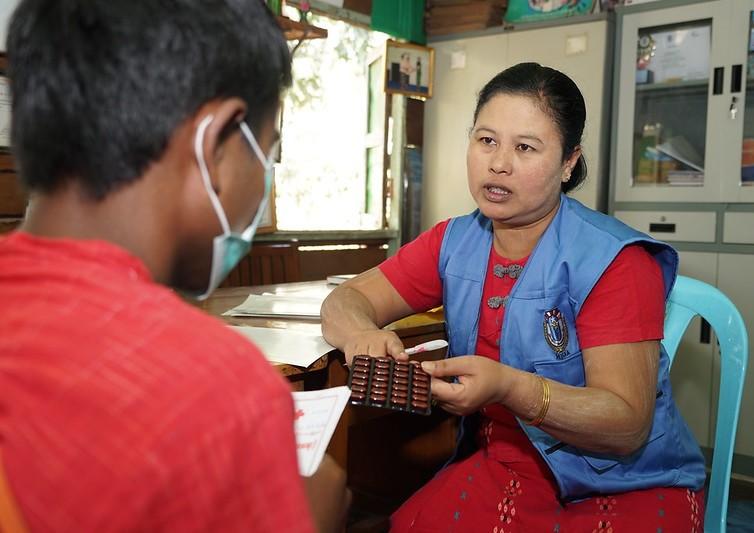New results from a phase 3 clinical trial show that a significantly shorter treatment regimen for highly drug-resistant tuberculosis (TB) remains highly effective even with a lower dosage of one the drugs.
The results, published yesterday in the New England Journal of Medicine, are another positive sign for the all-oral BPaL regimen, which combines the antibiotics bedaquiline, pretomanid, and linezolid. The 6-month regimen, approved by the US Food and Drug Administration in 2019, is now recommended by the World Health Organization (WHO) for treatment of people with highly resistant forms of the disease, which was the world's leading infectious disease killer before COVID-19 appeared.
The previously recommended treatment regimen for multidrug-resistant TB (MDR-TB) lasts anywhere from 9 to 24 months and involves multiple drugs, some with severe side effects, and has had a reported global success rate of only 52%. The poor efficacy of that regimen has been attributed in part to the inability of patients to adhere to the lengthy, expensive, and harsh treatment. Treatment for drug-sensitive TB typically lasts 6 months.
The trial results show that even with the dosage of linezolid—a drug that was associated with high rates of adverse events in previous trials of the regimen—cut in half, BPaL cured more than 90% of recipients, with fewer adverse events.
The president and CEO of TB Alliance, the nonprofit that developed pretomanid, says the findings reaffirm the potential of a treatment regimen he says is already a "sea change" from the previous treatment for MDR-TB, which affects roughly 500,000 people globally each year, only a third of whom receive treatment. The hope is that the easier treatment will enable national TB programs to treat and cure more MDR-TB patients.
"With a relatively simple 6-month regimen that cures 90% or more of patients who have MDR-TB…we can really make a huge impact on the drug-resistant TB problem around the world," Mel Spigelman, MD, told CIDRAP News.
High efficacy remains, with reduced side effects
For the ZeNix trial, Spigelman and colleauges at TB Alliance (which funded the trial), along with an international team of investigators, enrolled 181 participants with extensively drug-resistant TB (XDR-TB), pre-XDR-TB, or failed or treatment-intolerant MDR-TB from sites in South Africa, Russia, Georgia, and Moldova—all countries with a high burden of drug-resistant TB.
The participants were randomly assigned to four 26-week BPaL treatment arms with varying daily doses and durations of linezolid: 1,200 milligrams (mg) for 26 weeks, 1,200 mg for 9 weeks, 600 mg for 26 weeks, and 600 mg for 9 weeks.
The primary end point of the trial was incidence of an unfavorable outcome, defined as treatment failure or relapse, at 26 weeks after the end of treatment. But the investigators were also evaluating whether the lower dose and/or duration of linezolid would reduce adverse events, particularly peripheral neuropathy and myelosuppression, which occurred in 81% and 48% of BPaL recipients, respectively, in the Nix-TB trial. Both conditions are a known complication of prolonged linezolid treatment.
Even though the Nix-TB trial found that the BPaL regimen was more than 90% effective, Spigelman says investigators started enrolling patients in the ZeNix trial almost immediately to see if they could improve the regimen with a lower dosage of linezolid.
"There were fairly significant side effects, specifically from the linezolid at that dose [1,200 mg]," Spigelman said. "We saw what was happening and we thought we could do better."
The results of the primary efficacy analysis showed that 93% of patients who received BPaL with 1,200 mg for 26 weeks had a favorable outcome. The efficacy was similar in the other arms: 89% among those who received 1,200 mg of linezolid for 9 weeks, 91% for those who received 600 mg of linezolid for 26 weeks, and 84% for those who received 600 mg of linezolid for 9 weeks.
Analysis of adverse events found fewer occurrences of peripheral neuropathy (nerve damage) with the lower dose of linezolid: 38% among those who received 1,200 mg of linezolid for 26 weeks, 24% among those who received 1200 mg for 9 weeks, 24% among those who received 600 mg for 26 weeks, and 13% among those who received 600 mg for 9 weeks. Myelosuppression—when the bone marrow produces fewer red blood cells, white cells, and platelets—occurred in 22%, 15%, 2%, and 7% of patients, respectively.
"We saw that you can maintain the efficacy and markedly decrease the side effects from linezolid if you decrease the dose," Spigelman said. "There were still side effects, but almost nobody had to stop their treatment completely because of those side effects."
Based on these results, the ZeNix trail investigators determined that the better side-effect profile of BPaL with 600 mg of linezolid for 26 weeks, and the lower incidence of treatment failure compared with 600 mg of linezolid for 9 weeks (1 of 45 patients vs 4 of 45 patients), gives that regimen a more favorable risk-benefit ratio. Spigelman calls it the "sweet spot."
The WHO agrees with that assessment. In May, the agency issued a rapid communication on new treatment guidelines that recommend BPaL with 600 mg of linezolid as one the of two 6-month regimens to be used in patients with MDR- or rifampicin-resistant-TB in place of the longer regimens. Those guidelines should become official this fall. TB Alliance says the BPaL regimen has now been procured by more than 40 countries.
Developing better, shorter regimens
In an editorial that accompanies the study, TB experts from the Oxford University Clinical Research Unit, Ho Chi Minh City and the National Vietnam Tuberculosis Program say the findings of the ZeNix trial and the new WHO guidelines are "major advances for the ever-increasing numbers of persons worldwide who have drug-resistant tuberculosis."
But they add that more work to improve treatment is still needed, since the prospect of nearly a quarter of BPaL recipients developing peripheral neuropathy could still be a challenge for both patients and national TB programs.
"The priority now is to find a better balance between the efficacy of the new regimens and the toxic effects associated with prolonged linezolid treatment," Guy Thwaites, MBBS, PhD, and Nhung Nguyen, MD, PhD, write.
Spigelman says that work is well under way. Among the things that TB Alliance and its partners are looking at is whether they can make the treatment regimen even shorter and use the same regimen for all patients with drug-resistant TB, which could ease the burden on national TB treatment programs. They're also looking at the potential for a universal treatment that could cover both drug-resistant and drug-sensitive TB.
"It's a stepwise attempt to continuously improve what we're doing," he said.























